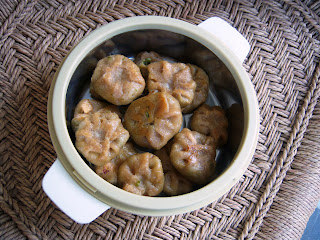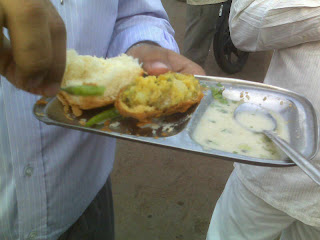
The strawberry season is on its way out and luckily this year I had some lovely strawberries come my way - at the same time that I brought some home from this trip to Maharashtra, my upstairs neighbour also got us some from his trip to Pune - thanks D!
Of course, with this surfeit of juicy,red strawberries I had to do *something* with them - especially since 4 year old has major issues with fruits which go "squish" in the mouth (which rules out most of them) and hubby is also not a great fan. I can't eat too much of raw fruit at one go and keeping them for too long would see them going bad. So, I looked about for some nice recipes - done the upside down cake (and I see others have been grappling with the same problem!).

Simply Recipes by Elise is one of my favourite go-to sites when I am looking for something in particular and I wasn't disappointed. She has this gorgeous recipe for Strawberry Mousse made with white chocolate. I didn't have white chocolate - but when has that ever stopped my from trying something! I used dark chocolate and adapted the recipe and it was fine - a slightly sweetish, tart dessert. I did this silly thing of pouring a layer of chocolate at the bottom of the glass - but of course since I didn't mix it with cream, it stuck to the bottom once it was cold. So after finishing the dessert I would pop it into the microwave for about 10 secs and then eat up the dark chocolate!
Strawberry Chocolate Mousse

Strawberries - 700gm
Dark chocolate - 200gms
200ml fresh cream (I used Amul fresh cream, but heavy cream, if available, is preferable)
2 tsp gelatine
2 tbsp powdered sugar
1. Soak the strawberries in water for 3-4 minutes and clean well. Dry, hull and chop up the strawberries, reserving about 5-6 strawberries for garnish and puree the rest in a blender. Slice the reserved strawberries and keep aside.
Pass through a sieve to filter the puree and keep aside.
2. Meanwhile, chop the chocolate and melt over a double boiler - put the chopped pieces into a small vessel which can fit into a bigger,shallow bowl which has water in it and keep the flame so that the water is barely simmering till the chocolate melts and is smooth. Pour into a large bowl.
3. Take about 1/4 cup of room temperature water and sprinkle the gelatine over the surface of the water - keep for about 5 minutes and stir lightly till mixed in.
4. Pour about 1/3 cup of the cream into a heavy sauce pan, mix in the powdered sugar and heat on a low flame. Add the gelatine water into the sauce pan and stir till dissolved - about 2-3 minutes.
5. Pour the cream and gelatine mixture into the melted chocolate, add the strawberry puree and mix well till completely combined.
6. Beat the remaining cream with a blender on high speed till it thickens and forms peaks ( Since I used fresh cream I whipped it over a bowl of ice). Fold the whipped cream into the chocolate-strawberry puree mixture till just combined. Refrigerate for 1 hour.
7. Pour the strawberry chocolate mousse into shot glasses and garnish each one with a couple of the reserved strawberry slices. Chill in the refrigerator overnight after covering each glass with clingfilm.


















